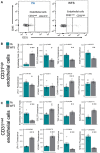Neuroinflammatory and Neurometabolomic Consequences From Inhaled Wildfire Smoke-Derived Particulate Matter in the Western United States
- PMID: 34865172
- PMCID: PMC8883349
- DOI: 10.1093/toxsci/kfab147
Neuroinflammatory and Neurometabolomic Consequences From Inhaled Wildfire Smoke-Derived Particulate Matter in the Western United States
Abstract
Utilizing a mobile laboratory located >300 km away from wildfire smoke (WFS) sources, this study examined the systemic immune response profile, with a focus on neuroinflammatory and neurometabolomic consequences, resulting from inhalation exposure to naturally occurring wildfires in California, Arizona, and Washington in 2020. After a 20-day (4 h/day) exposure period in a mobile laboratory stationed in New Mexico, WFS-derived particulate matter (WFPM) inhalation resulted in significant neuroinflammation while immune activity in the peripheral (lung, bone marrow) appeared to be resolved in C57BL/6 mice. Importantly, WFPM exposure increased cerebrovascular endothelial cell activation and expression of adhesion molecules (VCAM-1 and ICAM-1) in addition to increased glial activation and peripheral immune cell infiltration into the brain. Flow cytometry analysis revealed proinflammatory phenotypes of microglia and peripheral immune subsets in the brain of WFPM-exposed mice. Interestingly, endothelial cell neuroimmune activity was differentially associated with levels of PECAM-1 expression, suggesting that subsets of cerebrovascular endothelial cells were transitioning to resolution of inflammation following the 20-day exposure. Neurometabolites related to protection against aging, such as NAD+ and taurine, were decreased by WFPM exposure. Additionally, increased pathological amyloid-beta protein accumulation, a hallmark of neurodegeneration, was observed. Neuroinflammation, together with decreased levels of key neurometabolites, reflect a cluster of outcomes with important implications in priming inflammaging and aging-related neurodegenerative phenotypes.
Keywords: VCAM-1; microglia; neuroinflammation; neurovascular unit; particulate matter; smoke.
© The Author(s) 2021. Published by Oxford University Press on behalf of the Society of Toxicology. All rights reserved. For permissions, please e-mail: journals.permissions@oup.com.
Figures






Similar articles
-
Effects of wildfire smoke PM2.5 on indicators of inflammation, health, and metabolism of preweaned Holstein heifers.J Anim Sci. 2023 Jan 3;101:skad246. doi: 10.1093/jas/skad246. J Anim Sci. 2023. PMID: 37465977 Free PMC article.
-
Impact of Canadian Wildfire-Emitted Particulate Matter on THP-1 Lung Macrophage Health and Function.Environ Sci Technol. 2025 Mar 4;59(8):3869-3883. doi: 10.1021/acs.est.4c10304. Epub 2025 Feb 17. Environ Sci Technol. 2025. PMID: 39962934 Free PMC article.
-
Biomass smoke inhalation promotes neuroinflammatory and metabolomic temporal changes in the hippocampus of female mice.J Neuroinflammation. 2023 Aug 22;20(1):192. doi: 10.1186/s12974-023-02874-y. J Neuroinflammation. 2023. PMID: 37608305 Free PMC article.
-
The firestorm within: A narrative review of extreme heat and wildfire smoke effects on brain health.Sci Total Environ. 2024 Apr 20;922:171239. doi: 10.1016/j.scitotenv.2024.171239. Epub 2024 Feb 27. Sci Total Environ. 2024. PMID: 38417511 Review.
-
Impact of Wildfires on Cardiovascular Health.Circ Res. 2024 Apr 26;134(9):1061-1082. doi: 10.1161/CIRCRESAHA.124.323614. Epub 2024 Apr 25. Circ Res. 2024. PMID: 38662865 Free PMC article. Review.
Cited by
-
Adapting to Climate Change: Leveraging Systems-Focused Multidisciplinary Research to Promote Resilience.Int J Environ Res Public Health. 2022 Nov 8;19(22):14674. doi: 10.3390/ijerph192214674. Int J Environ Res Public Health. 2022. PMID: 36429393 Free PMC article. Review.
-
Neuroinflammatory and Metabolomic Temporal Dynamics Following Wood Smoke Inhalation.Res Sq [Preprint]. 2023 Jun 5:rs.3.rs-3002040. doi: 10.21203/rs.3.rs-3002040/v1. Res Sq. 2023. Update in: J Neuroinflammation. 2023 Aug 22;20(1):192. doi: 10.1186/s12974-023-02874-y. PMID: 37333410 Free PMC article. Updated. Preprint.
-
Aging, longevity, and the role of environmental stressors: a focus on wildfire smoke and air quality.Front Toxicol. 2023 Oct 11;5:1267667. doi: 10.3389/ftox.2023.1267667. eCollection 2023. Front Toxicol. 2023. PMID: 37900096 Free PMC article. Review.
-
Recent Review on Selected Xenobiotics and Their Impacts on Gut Microbiome and Metabolome.Trends Analyt Chem. 2023 Sep;166:117155. doi: 10.1016/j.trac.2023.117155. Epub 2023 Jun 28. Trends Analyt Chem. 2023. PMID: 37484879 Free PMC article.
-
Current understanding of the impact of United States military airborne hazards and burn pit exposures on respiratory health.Part Fibre Toxicol. 2024 Oct 21;21(1):43. doi: 10.1186/s12989-024-00606-5. Part Fibre Toxicol. 2024. PMID: 39434148 Free PMC article. Review.
References
-
- Agency USEP. (1997). Reference method for the determination of fine particulate matter as PM2.5 in the atmosphere. EPA 40 CFR Part 50, Washington, DC, Appendix L.
-
- Ahmadi Z., Arababadi M. K., Hassanshahi G. (2013). CXCL10 activities, biological structure, and source along with its significant role played in pathophysiology of type I diabetes mellitus. Inflammation 36, 364–371. - PubMed
-
- Aragon M., Erdely A., Bishop L., Salmen R., Weaver J., Liu J., Hall P., Eye T., Kodali V., Zeidler-Erdely P., et al. (2016a). MMP-9-dependent serum-borne bioactivity caused by multiwalled carbon nanotube exposure induces vascular dysfunction via the CD36 scavenger receptor. Toxicol. Sci. 150, 488–498. - PMC - PubMed
-
- Aragon M. J., Topper L., Tyler C. R., Sanchez B., Zychowski K., Young T., Herbert G., Hall P., Erdely A., Eye T., et al. (2017). Serum-borne bioactivity caused by pulmonary multiwalled carbon nanotubes induces neuroinflammation via blood-brain barrier impairment. Proc. Natl. Acad. Sci. U.S.A. 114, E1968–E1976. - PMC - PubMed
Publication types
MeSH terms
Substances
Grants and funding
LinkOut - more resources
Full Text Sources
Medical
Miscellaneous

